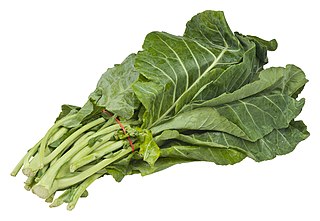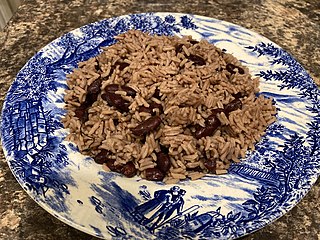
Soul food is the ethnic cuisine of African-Americans. It originated in the American South from the cuisines of enslaved Africans trafficked to the North American colonies through the Atlantic slave trade during the Antebellum period and is closely associated with the cuisine of the American South. The expression "soul food" originated in the mid-1960s, when "soul" was a common word used to describe African-American culture. Soul food uses cooking techniques and ingredients from West African, Central African, Western European, and Indigenous cuisine of the Americas. Soul food came from the blending of what African Americans ate in their native countries in Africa and what was available to them as slaves. The cuisine had its share of negativity initially. Soul food was initially seen as low class food, and Northern African Americans looked down on their Black Southern counterparts who preferred soul food. The term evolved from being the diet of a slave in the South to being a primary pride in the African American community in the North such as New York City.

The cuisine of the Southern United States encompasses diverse food traditions of several subregions, including Tidewater, Appalachian, Ozarks, Lowcountry, Cajun, Creole, African American Cuisine and Floribbean cuisine. In recent history, elements of Southern cuisine have spread to other parts of the United States, influencing other types of American cuisine.

The black-eyed pea or black-eyed bean is a legume grown around the world for its medium-sized, edible bean. It is a subspecies of the cowpea, an Old World plant domesticated in Africa, and is sometimes simply called a cowpea.

Collard is a group of loose-leafed cultivars of Brassica oleracea, the same species as many common vegetables including cabbage and broccoli. Part of the Acephala (kale) cultivar group, it is also classified as the variety B. oleracea var. viridis.

The Gullah are an African American ethnic group who predominantly live in the Lowcountry region of the U.S. states of South Carolina, North Carolina, Georgia, and Florida within the coastal plain and the Sea Islands. Their language and culture have preserved a significant influence of Africanisms as a result of their historical geographic isolation and the community's relation to their shared history and identity.

Pabellón criollo is a traditional Venezuelan dish that is considered the national dish. It mixes elements from the three different cultures that intermixed during Spanish colonials times: Native Americans, Spanish and Africans. The name is a synonym to flag, since it was one of the main original associations. It is a plate of rice, shredded beef in stew and stewed black beans.

Red beans and rice is an emblematic dish of Louisiana Creole cuisine traditionally made on Mondays with Kidney beans, vegetables, spices and pork bones as left over from Sunday dinner, cooked together slowly in a pot and served over rice. Meats such as ham, sausage, and tasso ham are also frequently used in the dish. The dish is customary – ham was traditionally a Sunday meal and Monday was washday. A pot of beans could sit on the stove and simmer while the women were busy scrubbing clothes. The dish is now fairly common throughout the Southeast. Similar dishes are common in Latin American cuisine, including moros y cristianos, gallo pinto and feijoada.
Soup beans is a term common in the Southern United States, particularly the regions around the Appalachian Mountains. Soup beans are usually served with cornbread, greens, and potatoes and may be topped with raw chopped onions or ramps. Soup beans are considered a main course, but also serve as a side dish. In rural areas, where food was scarce during the winter, these dried beans were a staple food.

Rice and beans, or beans and rice, is a category of dishes from many cultures around the world, whereby the staple foods of rice and beans are combined in some manner. The grain and legume combination provides several important nutrients and many calories, and both foods are widely available. The beans are usually seasoned, while the rice may be plain or seasoned. The two components may be mixed together, separated on the plate, or served separately.

Rice and peas or peas and rice are traditional rice dishes within some Caribbean countries. The 'peas' used in this dish by some countries are traditionally pigeon peas otherwise called 'Gungo peas' in the Caribbean. Nowadays, either kidney beans or pigeon peas are being traditionally used. Rice and peas recipes throughout the Caribbean vary, with each country having their own way of making it and name of calling it, and are similar only by the two main ingredients which are the legumes (peas/beans) used and rice to form a mixture. The name "rice and peas" originally is used by Jamaicans to identify the dish, while other countries have different names for it.

Pork jowl is a cut of pork from a pig's cheek. Different food traditions have used it as a fresh cut or as a cured pork product. As a cured and smoked meat in America it is called jowl bacon or, especially in the Southern United States, hog jowl, "'joe bacon"' or joe meat. In the US, hog jowl is a staple of soul food, and there is a longer culinary tradition outside the United States; the cured non-smoked Italian variant is called guanciale.

Sea Island red pea is an heirloom landrace of cowpea from the Gullah corridor of the Sea Islands. They are an integral part of Gullah cuisine and have been listed on the Ark of Taste.

Texas caviar, also called cowboy caviar, is a bean salad consisting of black-eyed peas lightly pickled in a vinaigrette-style dressing, often eaten as a dip accompaniment to tortilla chips.
New Year's foods are dishes traditionally eaten for luck in the coming year. Many traditional New Year dishes revolve around the food's resemblance to money or to its appearance symbolizing long life, such as long noodles or strands of sauerkraut. Some cultures and religions have evolved complex food traditions associated with the new year.

Arroz de fríjol cabecita negra is a rice-based dish from the Caribbean Coast of Colombia that utilizes black-eyed peas as the legume, differing from other rice dishes that are usually prepared with different legumes such as beans, peas, lentils, and Pigeon peas.















